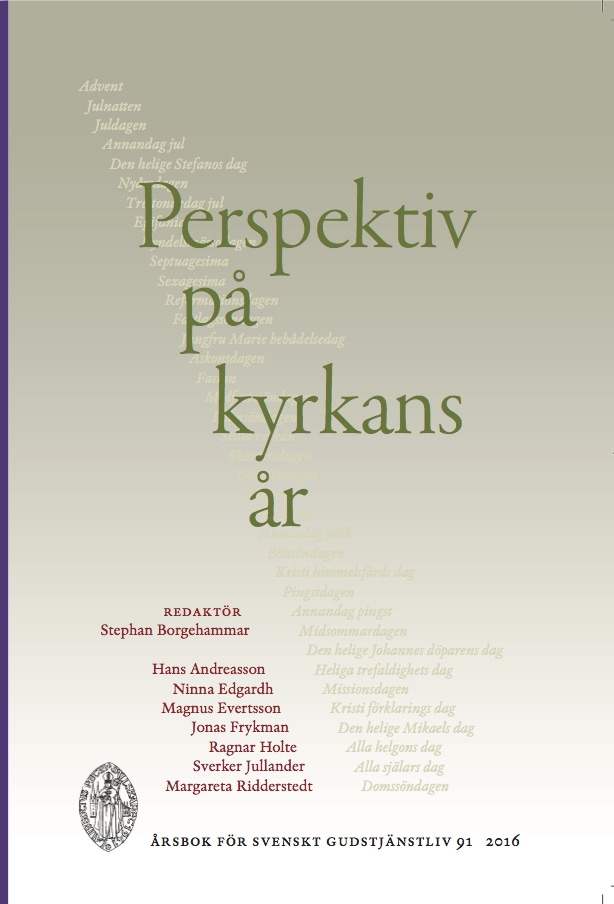De tempore. Kyrkomusikerns gestaltning av kyrkoåret i högmässan
Abstract
De Tempore. The Representation of the Liturgical Year by the Church Musician in the Mass
The function of music in worship may be described as serving. Its contribution may be considerable, but it is not at the centre. The choice of repertory must therefore be subordinated to the occasion, the character of which in the Church of Sweden is largely determined by the liturgical year. We may call this the de tempore principle. The article deals with three areas in which the de tempore principle needs to be considered: the choice of hymns, the choir repertory and the organ postlude.
Before 1921, only the texts in Swedish hymn books had royal sanction, not the melodies. This may have given organists some freedom of choice. Since the year 2000, the Church Order lays down that priests must consult the church musician when choosing hymns (text and melody) for a service. The choice of hymns is important in communicating a feel for the liturgical year, and musicians are often more experienced than priests in this matter. The de tempore character of hymns may need to be underscored by the way they are executed, for instance in the season of Advent: the first Sunday has a festal character whereas the following three focus on repentance, yet certain hymns may be used both on the first and on subsequent Sundays and should then be played differently.
The service manual (Kyrkohandbok) of 1894 was the first to mention that choir song could take place during the Sunday service, after the Creed. Bishop U. L. Ullman and the church musician John Morén published in 1914 a proposed official ”Hymnarium” for choirs, where in the Introduction they strongly advocated a de tempore principle. This Hymnarium never became official, however, nor did any subsequent attempts. But from this time on, the participation of the choir in Church worship was strongly advocated and many collections of choral music for this purpose were published. In the three-volume collection Koralmusik (1957–64), the singing of songs alternatim between choir and congregation was introduced. At this time, many new compositions of Church music for choir also appeared. The publication Evangeliespråk (1964, new ed. 1994–95) had choir settings of parts of the Gospel text for every Sunday and feast of the liturgical year. During the 1970s, the repertory was enriched by much material from the Anglican tradition. The most recent major contribution is Sven-David Sandström’s Musik för kyrkoåret (”Music for the Liturgical Year,” 2012), with new compositions for the whole liturgical year for choir and, sometimes, organ or strings, which has revitalized the de tempore idea as a basis for both composition and choice of repertory.
The chief task of the organist during worship is to improvise chorale preludes and accompany congregational singing. Freely chosen notated music is usually only played at the end, as postlude. The first official service manual (Kyrkohandbok) to mention the possibility of an organ piece after the final hymn is the one of 1942. The laconic rubric makes it clear that this is voluntary, is for organ only and should be ”ecclesiastically dignified”. The intention was that the congregation should remain seated in their pews while this music was played. A connection to the liturgical year was not required, but many organists had such an ambition and several collections of suitable music arranged according to the de tempore principle were published 1928–1948. Since then, no new such collections have appeared, but one may ask whether freely chosen pieces may have (or can be given) a de tempore character. Festal occasions are easy, but what about the ”ordinary” Sundays after Trinity? The article gives suggestions for four such Sundays. Certain works suggest themselves due to genre, textual connections, melodic motifs (e.g. from well-known hymns) or symbolic motifs.
Although the elements of Mass and liturgical year form the basis for the choice of repertory, the church musician has to consider many other factors: the size and capacity of the choir, local traditions, the size and type of organ, one’s own capacity, the availability of soloists etc. The challenge is not to lose focus on the ”basic elements”, including the de tempore principle. The ideal should be to choose hymns first, then add suitable music for choir and organ. Why not decide the hymns for six months at a time?
Certain seasons are provided with a musical embarras de richesse while for others there is a dearth of dedicated music. But to find suitable music is an interesting task. An especial challenge for the church musician is to clarify nuances within one and the same season of the liturgical year, e.g. the theme of struggle in the first Sundays of Lent which switches to a focus on the Atonement in Passiontide with Laetare Sunday in between.
Is the de tempore principle being upheld today? Recent years have seen a lot of new music being published for the various liturgical seasons. On the other hand there is an increased frequency of ”theme services” that do not connect with the liturgical year, a weakened emphasis on musical variation for the liturgical year in the proposed new service manual (2016), and an increased use of ”songs of praise” in worship. This is not the place to discuss in depth the benefits of upholding the de tempore principle, but it is clear that a consistent, thoughtful application of this principle gives direction and stimulus to the work of the church musician, a positive awareness of the special character of his or her task, and an immersion in the meaning of Christian worship.
Downloads
Published
Issue
Section
License
© the authors, Laurentius Petri Sällskapet för Svenskt Gudstjänstliv and Artos & Norma Bokförlag. Copying and using material from Svenskt Gudstjänstliv for scholarly purposes is permitted as long as the source is indicated. For other uses, please contact the respective author as well as the publisher. Special restrictions may apply to images.


